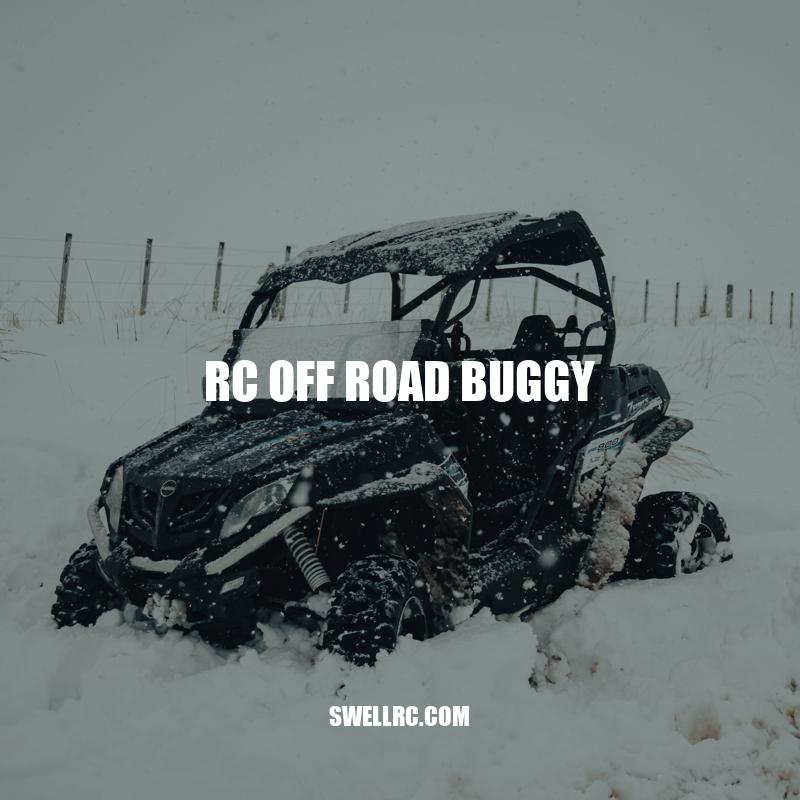Everything You Need to Know About RC Off-Road Buggies
RC off-road buggies are a popular and exciting way to experience the thrill of off-road driving in miniature form. These small-scale models are operated remotely and come in a range of designs and sizes suitable for everyone, from kids to adults. RC off-road buggies are a great way to enjoy off-road driving without leaving the comfort of your backyard. These tiny vehicles can be driven on various terrains such as sand, dirt, and rocks, mimicking the driving experience of an actual off-road buggy. They offer a fun and challenging way to navigate different terrains using skill, speed, and strategy. People of all ages can enjoy this thrilling hobby, whether you are a total beginner or a seasoned pro. There are different types of RC off-road buggies available in the market, ranging from electric to nitro-powered models, catered to different skill levels. In this article, we will discuss the various types of RC off-road buggies, features to consider before purchasing one, and how to maintain them in good working condition.
Types of RC Off-Road Buggies
There are several different types of RC off-road buggies available, each with their own advantages and disadvantages. Some of the most common types include:
- Electric-powered buggies: These buggies are easy to control and require minimal maintenance, making them ideal for beginners. They are also quieter than other types of off-road buggies and can be used indoors.
- Gas-powered buggies: These buggies are more realistic than electric-powered ones and are favored by experienced drivers. They are typically faster than electric-powered buggies and have a longer runtime, but also require more maintenance.
- Nitro-powered buggies: These buggies are the most powerful and fastest of the three types. They are also the most expensive and require the most maintenance.
When choosing an RC off-road buggy, it’s essential to consider factors like your budget, experience level, and intended use. Sites like Amazon and Hobbyking offer a variety of options to suit a range of needs and preferences. It’s also worth reading reviews and watching videos to get a better idea of the pros and cons of each type of buggy.
‘What factors should I consider when choosing an RC off-road buggy’?
When choosing an RC off-road buggy, there are several factors to consider to ensure you get the right vehicle for your needs. The first thing to think about is the type of terrain you plan to drive on. If you’re planning on taking your buggy off-road, you’ll need a vehicle with appropriate ground clearance, suspension, and tires.
Another factor to consider is the size and weight of the RC buggy. If you’re planning on racing your buggy, you may want to choose a smaller, lighter model that’s built for speed and maneuverability. However, if you’re looking for a vehicle for recreational use, you may prefer a larger, bulkier model that can tackle tough terrain and is more stable on rough terrain.
Durability is also an important consideration when choosing an RC off-road buggy. Look for a vehicle that’s built to last, with sturdy materials and a solid construction. You don’t want to invest in a vehicle that will break down or wear out after just a few uses.
Other factors to consider include the type of battery the buggy uses, the level of control you have over the vehicle, and the overall performance of the vehicle. With so many options on the market, it’s important to do your research and choose the best RC off-road buggy for your needs and budget.
Features to Consider When Buying an RC Off-Road Buggy
When buying an RC off-road buggy, there are several features to consider to ensure that you get the best product for your needs. Here are some important features to keep in mind:
- Terrain: Consider the types of terrain you’ll be driving your buggy on. If you plan to stick to smooth surfaces like pavement or hardwood floors, a lightweight buggy with smaller wheels may suffice. If you plan to tackle rough, uneven terrain, you’ll want a heavier, more durable buggy with a heavy-duty suspension system.
- Motor power: The motor power will affect the speed and agility of your buggy. If you’re a beginner driver, you may want to opt for a buggy with a lower-powered motor to make controlling the vehicle easier. More advanced drivers may prefer a buggy with a higher-powered motor for better speed and control.
- Battery life: The amount of time your buggy can be used on a single charge will depend on the battery life. If you plan to use your buggy for longer periods, look for one with a higher capacity battery pack. Most batteries take around an hour or two to fully charge and can provide between 10 to 25 minutes of run time depending on the model.
- Controller: A good controller is essential for getting the most out of your off-road buggy. Look for features like adjustable trim, dual rate controls, and multiple channels to customize your driving experience.
Additionally, some RC off-road buggy models may also include features like waterproofing, shockproofing, and LED headlights for enhanced performance and style.
Here is a comparison table of some popular RC off-road buggy models:
| Model | Type | Terrain | Motor Power | Battery Life | Price |
|---|---|---|---|---|---|
| Traxxas Slash 4X4 | Electric | All-Terrain | Brushless | 25 min | $479.99 |
| Redcat Racing Blackout SC | Electric | All-Terrain | Brushed | 10-15 min | $219.99 |
| HPI Racing Baja 5B Flux | Electric | Off-Road | Brushless | 20-30 min | $1,099.99 |
| Losi DBXL-E 2.0 | Electric | All-Terrain | Brushless | 35 min | $1,199.99 |
Remember to budget for additional costs like batteries, chargers, and spare parts, and always read the manual and follow safety guidelines to ensure a safe and enjoyable experience.
‘What additional costs should be considered when purchasing an RC off-road buggy’?
Purchasing an off-road buggy is not just about the initial cost of the vehicle. There are additional expenses that should be considered before making the purchase. Here are some factors:
First and foremost, batteries are a crucial aspect of an RC off-road buggy as it powers the vehicle. Battery life inevitably decreases over time, so purchasing additional batteries and a charger is a must. These additional batteries will allow for longer run times particularly during an off-road race or outdoor activities.
Spare parts are another expense that should be considered as they can make or break the enjoyment of the racing experience. RC off-road buggies can be vulnerable to wear and tear, resulting in broken parts such as shocks, drive shafts, and tires. Replacing these parts can be costly and time-consuming, as they need specific and high-quality parts.
Additionally, if you’re planning on racing, there may be entry fees to participate in organized events and races. This will require extra funds to devote to this sport.
Finally, transportation costs and storage for the off-road buggy must also be taken into account. It’s always essential to have secure storage for the vehicle to prevent any damage being done to the car. If the nearest off-road racing venue is not in proximity, then transportation costs may be a factor that needs to be considered.
In conclusion, when purchasing an off-road buggy, your costs don’t stop at the initial price. Once you have your buggy, be prepared for additional expenditure, such as batteries, spare parts, race entry fees, transportation, and storage. All these costs will ensure the enjoyment of the off-road experience for years to come.
Maintenance and Repair
Taking proper care of your RC off-road buggy is essential to keep it running smoothly and prevent damage. Here are some basic maintenance and repair tips for your buggy:
- Cleaning: Regularly clean the buggy to keep it free of dirt, debris, and moisture. Wipe down the tires, body, and undercarriage with a damp cloth to remove any accumulated grime.
- Lubrication: Lubricate the moving parts of the buggy, such as the wheel bearings and driveshaft, with oil or silicone spray to prevent rust and enhance performance.
- Checking for loose screws: Inspect the buggy for any loose screws or attachments before and after use. Tighten any that may have come loose with a screwdriver or Allen wrench.
- Battery: Charge the battery fully before each use and store it in a cool, dry place when not in use. Avoid overcharging the battery, which can damage it.
If your RC off-road buggy requires repairs, it’s essential to have a basic understanding of how it works, or seek professional help. Here are some common issues that may require repair:
- Broken parts: Replace any broken parts of the buggy, such as wheels, gears, or suspension components, as soon as possible to prevent further damage.
- Motor issues: If the motor is not working correctly, inspect for any loose or damaged wiring and connections. If the problem persists, it may require a replacement motor.
- Controller problems: Check the controller for battery issues or loose connections. If the problem persists, it may require repair or a replacement controller.
There are several websites and stores where you can find RC off-road buggy parts and accessories, such as Amazon, Horizon Hobby, and Tower Hobbies. Before purchasing, ensure that the parts or accessories are compatible with your specific RC off-road buggy model.
‘Where can I find RC off-road buggy parts and accessories’?
If you’re in search of high-quality parts and accessories for your RC off-road buggy, there are several options available to you. One of the most popular places to start looking is online, where you can find a wide variety of options from multiple retailers. Some of the best online stores to check out include Amazon, HobbyPartz, and RC Planet. These websites have a huge selection of different parts and accessories to choose from, so you’re sure to find exactly what you need.
If you’re looking for more personalized service, you can always check out local hobby stores in your area. Many of these stores carry a selection of RC off-road buggy parts and accessories. They may also have knowledgeable staff who can help you find the right parts for your specific needs. It’s always a good idea to call ahead to see what kind of selection they have available, so you don’t waste your time going to a store that doesn’t carry what you need.
If you’re really serious about RC off-road buggies, you may even want to consider attending an RC off-road buggy race or event. These events are a great way to meet other enthusiasts and learn more about the sport. They often have vendors on hand selling parts and accessories, so you can get what you need while you’re there. Plus, you’ll get to see some amazing off-road buggies in action, which is a treat in itself!
Whatever your needs are, there’s no shortage of options when it comes to finding RC off-road buggy parts and accessories. With a little bit of research and some patience, you’re sure to find exactly what you need to keep your buggy running smoothly and looking great.
Conclusion
An RC off-road buggy is a thrilling toy that can bring endless hours of enjoyment for kids and adults alike. By selecting the right type of buggy, features, and maintenance routine, you can ensure that your buggy runs smoothly and lasts for years. Remember to choose an appropriate type of buggy that matches your skill level and intended use and to maintain it regularly to avoid any damage or malfunctions.
Aside from being entertaining, an RC off-road buggy is an excellent way to learn about mechanics and engineering. You get to see firsthand how different components work together, and you can even make modifications to enhance its performance. With so many types of RC off-road buggies available in the market today, there’s a buggy to suit everyone’s tastes and preferences.
Whether you’re racing against friends or honing your driving skills, an RC off-road buggy is an exciting and challenging way to spend quality time outdoors. So why wait? Get your hands on an RC off-road buggy today and let the fun begin!



